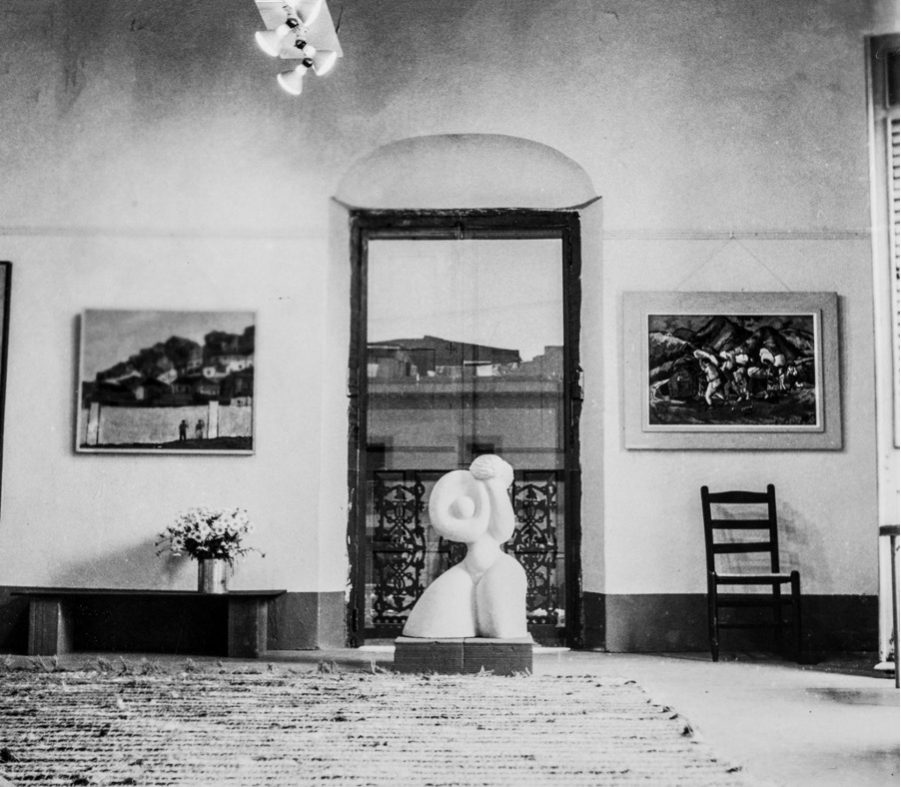Main exhibition space at the Centro de Arte Puertorriqueño, with a view toward Calle San José, July 1951. (Painting on the right: Samuel Sánchez, Untitled. Left: Rafael Tufiño, La muralla del cementerio [The Cemetery Wall], 1951. Sculpture in the center: Luisa Géigel, Untitled). Photo: Lorenzo and Dorothy Homar Estate.
[spacer height=”20px”]Texto completo / Full text
PDF / EPUB
Title: Inside the Centro de Arte Puertorriqueño (CAP)
Título: En el interior del Centro de Arte Puertorriqueño (CAP)
Autor / Author: José Correa Vigier
Asociación Internacional de Críticos de Arte, Capítulo de Puerto Rico
Abstract: The Centro de Arte Puertorriqueño (Puerto Rican Art Center), an art gallery and creative space—which was founded in 1950 and known by its Spanish initials (CAP)—represented a transitional cultural venue aimed at providing a new definition of modern art and identity in Puerto Rico. The work carried out by its founding members has served as a focus for numerous exhibitions and essays that underscore the importance of this initiative. The events and activities featured at the Center included exhibitions, art workshops, and the publication of graphic portfolios associated with defining Puerto Rican identity. Despite the importance and renown of the CAP, no photographs have been previously identified illustrating the spatial distribution and objectives of the venue. Seventy-three years after its foundation, the historian José Correa Vigier has managed to locate and identify the first images of the CAP interior, some of its founding members and associates, and the context and purposes of its spaces.
Resumen: El Centro de Arte Puertorriqueño, galería de arte y espacio creativo, fundado en 1950 y conocido por sus siglas (CAP), presentó una propuesta plástica transicional hacia la nueva definición del arte moderno e identitario en Puerto Rico. La gestión de sus artistas fundadores ha sido motivo de numerosas exposiciones y ensayos que demuestran la importancia de su fundación. Entre los eventos relevantes del Centro se celebraron exposiciones, talleres de arte y la publicación de portfolios gráficos asociados a la identidad puertorriqueña y su definición. A pesar de la notoriedad del CAP, hasta el momento no se habían identificado fotografías que definieran la distribución y objetivos de sus facilidades. Después de 73 años de su fundación, el historiador José Correa Vigier rescató las primeras imágenes que ilustran los interiores del CAP, algunos de sus miembros fundadores y asociados, y el contexto y propósitos de sus espacios.
Keywords: CAP, Puerto Rican Art Center, identity, identity art, Lorenzo Homar, Rafael Tufiño, Félix Rodríguez Báez, José Antonio Torres Martino, Julio Rosado del Valle, Irene Delano, Rubén Rivera Aponte, Carlos Raquel Rivera, José Correa Vigier.
Palabras clave: CAP, Centro De Arte Puertorriqueño, identidad, arte identitario, Lorenzo Homar, Rafael Tufiño, Félix Rodríguez Báez, José Antonio Torrres Martino, Julio Rosado del Valle, Irene Delano, Rubén Rivera Aponte, Carlos Raquel Rivera, José Correa Vigier.
Sección: Inglés / Section: English
Recibido / Received: 9 de enero de 2023 Aceptado / Accepted: 15 de febrero de 2023.
Cita recomendada: Correa Vigier, José. “Inside the Centro de Arte Puertorriqueño (CAP)” Visión Doble: Revista de Crítica e Historia del Arte, 16 de mayo de 2023, humanidades.uprrp.edu/visiondoble

